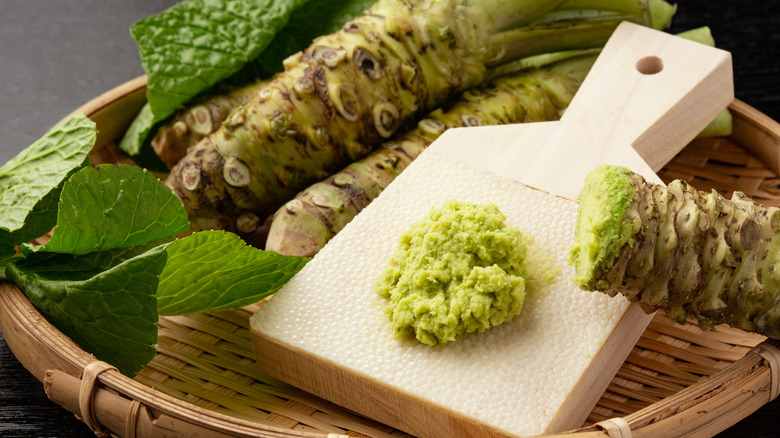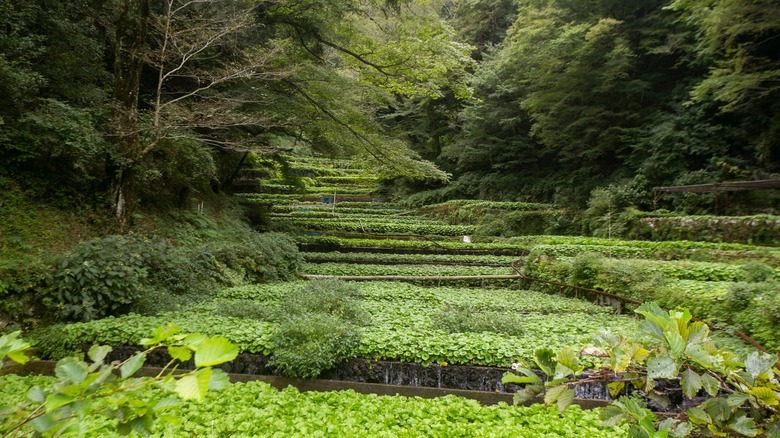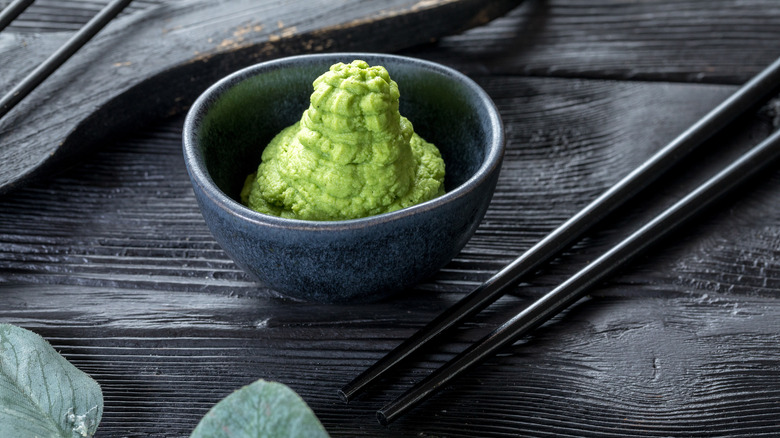Why Is Real Wasabi So Expensive?
We may receive a commission on purchases made from links.
Chances are, the zingy green mash accompanying your sushi and sashimi did not come from actual wasabi. The original condiment — real wasabi — is made from Japanese horseradish, a.k.a. Wasabia japonica or Eutrema japonicum. Meanwhile, most of the "wasabi" served at restaurants, found at the store or in packaged foods, is a mixture of regular horseradish, mustard extracts, and a few flavoring ingredients.
The high price of true, prepared wasabi comes down to the scarcity of the plant from which it comes. The Japanese horseradish rhizome is notoriously fickle to grow and many sushi restaurants don't want to shock customers with its price, preferring the cheap and easy substitute. Easier because true wasabi tends to quickly lose its potency once grated and served. As to price, you can expect to pay roughly $5 more for a usual serving of the stuff. Because customers have more experience with a facsimile of real wasabi, and might even be a bit thrown off by the flavor and consistency of the real deal, only shops local to where it's grown and purveyors seeking a very authentic experience care to bother with it.
Real wasabi requires a rare plant, loads of time (and sometimes even sharkskin!)
The wasabi plant is part of the Brassicaceae family, which encompasses other pungent members like radish, mustard, horseradish, and cabbage. Native to Japan and historically grown in the country's mountainous Nagano prefecture, the wasabi plant requires very specific climactic conditions to germinate. Plus, its root-like stem (the rhizome) develops a muddy, bitter taste without constant flowing water. Therefore, Nagano's clear-running streams are perfect for it, but there aren't too many other areas around the world where wasabi is successfully grown. The rhizomes also take about two years to become large enough to harvest.
Wasabi paste is obtained by grating the stem gently on a rough surface. Traditional chefs use sharkskin for its sandpaper-like texture, and once enough of the soft green spread has accumulated, it needs to be served immediately. It's a strictly made-to-order condiment and needs to be grated fresh off the stem each time.
Real wasabi vs supermarket wasabi
The wasabi plant's ubiquitous cousin, horseradish, is the dominant ingredient in what passes as wasabi in most places. In his book "The Story of Sushi: An Unlikely Saga of Raw Fish and Rice," author Trevor Corson reveals the substitute as a mixture of horseradish, mustard extracts, citric acid, and food coloring. It comes packaged as a water-soluble powder or as a paste, which gives it a thicker consistency than freshly grated wasabi.
Both wasabi and horseradish get their signature spiciness from the presence of isothiocyanates (ITCs), which are volatile molecules that float up and fill the nasal passages, acting as irritants. However, the dominant ICT in horseradish is known for its sharp pungency and strong radish-like flavor. On the other hand, real wasabi contains a wide variety of ITCs, giving it a more complex flavor and fresh, spicy, even unctuous aroma; the kick is milder with a cleaner finish.
Connoisseurs attest that real wasabi's subtle complexity is better matched to the delicate flavors of raw fish, and some chefs will also place fresh wasabi between the rice and the fish to protect its effervescent flavor, which can dissipate in as little as 15 minutes after grating. This is another aspect where storebought and real wasabi differ. The former, which has a high amount of durable horseradish ITCs, can retain pungency and flavor for much more extended periods, making it a convenient, if slightly spurious, substitute.


